The Quality of ETICS in the Context of Energy and Social Changes (Case Study)
Abstract
:1. Introduction
2. Method of Study
- Selection of urbanized area with housing development and selection of the building (field survey);
- Visual inspection of selected objects and diagnostics including examination of the influence of external factors on the growth of microorganisms (field survey);
- Sampling and microscopic survey of the surface of external plasters (diagnostics);
- Laboratory analysis of collected samples, definition of the type of microorganisms (diagnostics);
- Comparison and evaluation.
3. Theoretical Basis
3.1. Analysis and Evaluation of Apartment Building Number 1
3.2. Analysis and Assessment of Apartment Building Number 2
4. Results and Discussion
4.1. Results of the Apartment Building Number 1
4.2. Results of the Apartment Building Number 2
4.3. Technological Aspects of Exterior ETICS Facades
4.4. Remarks
- Diagnostic aspects prior to the actual use of ETICS or before the application of protective photocatalytic coatings following the recommended standards and methodologies;
- Diagnostics and laboratory analyses of ETICS surfaces, which are affected by micro cracks, to determine whether these create the potential for the growth of carcinogenic fungi under external plaster, and to eliminate the possible potency of allergens;
- Environmental contexts in the given urbanized housing development zone.
5. Conclusions
Funding
Institutional Review Board Statement
Informed Consent Statement
Data Availability Statement
Conflicts of Interest
Appendix A
- Locality 1 (city of Ostrava and selected territory): number of buildings: 9.
- Locality 1 (town Havířov and selected territory): number of buildings: 33.
Appendix B
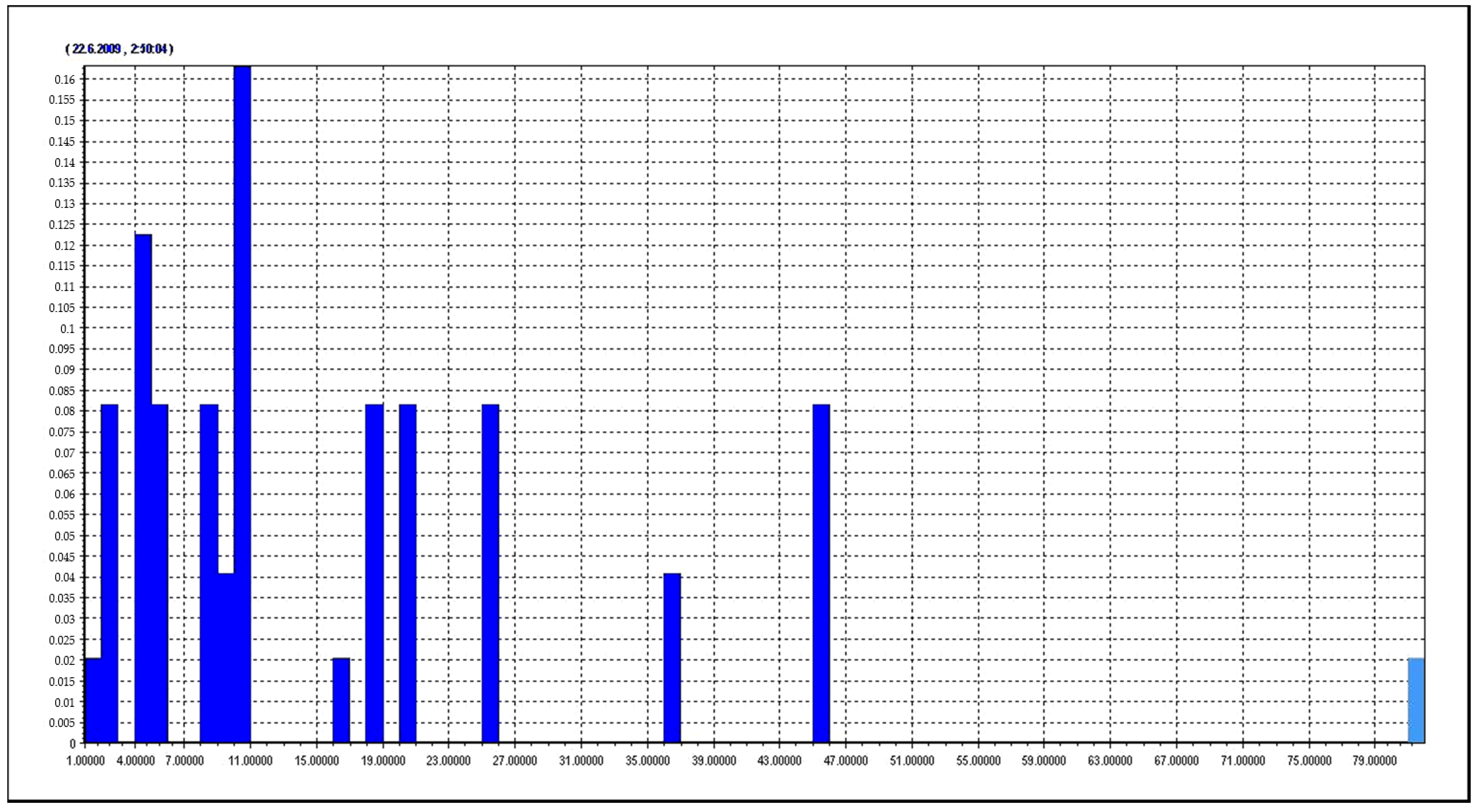
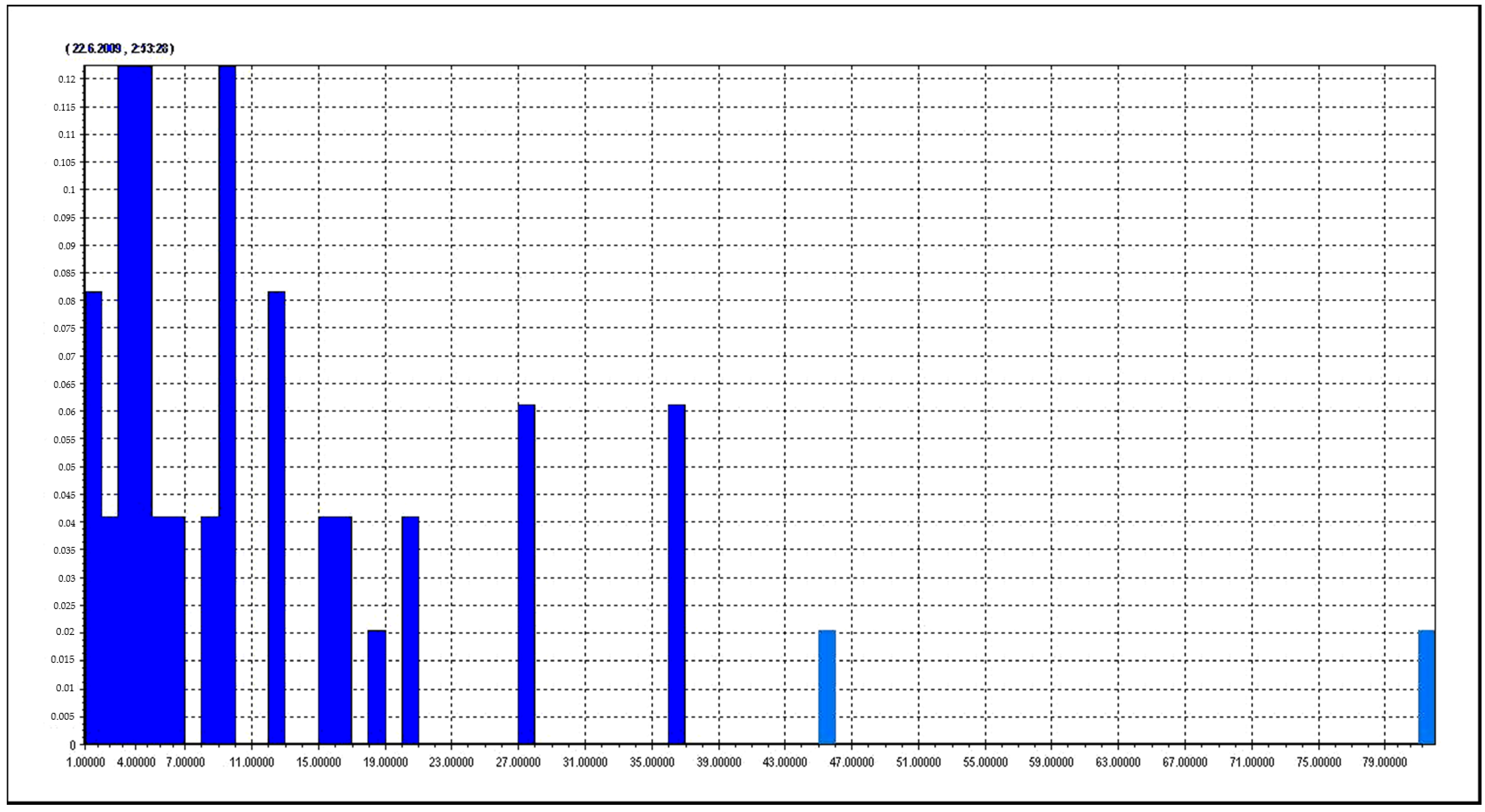
References
- ČSN 73 2901; Performance of External Thermal Insulation Composite Systems (ETICS). Office for Technical Standardization, Metrology and State Testing: Prague, Czech Republic, 2005.
- ČSN 73 0540-2; Thermal Protection of Buildings-Part 2: Requirements. Office for Technical Standardization, Metrology and State Testing: Prague, Czech Republic, 2011.
- Csoknyai, T.; Hrabovszky-Horváth, S.; Georgiev, Z.; Jovanovic-Popovic, M.; Stankovic, B.; Villatoro, O.; Szendrö, G. Building stock characteristics and energy performance of residential buildings in Eastern-European countries. Energy Build. 2016, 132, 39–52. [Google Scholar] [CrossRef]
- Kubečková, D. Past and Perspectives of Panel Housing Construction; Inaugural Lecture; VSB-TUO: Ostrava, Czechia, 2010. [Google Scholar]
- Insulation Reduces Energy Costs by Up to 45%. Available online: https://stavba.tzb-info.cz/izolace-strechy-fasady/128851-zatepleni-snizuje-naklady-na-energie-az-o-45 (accessed on 19 January 2022).
- Directive No. 78/2013 Energy Performance of Buildings (CZ). Available online: www.eu.europe.eu (accessed on 1 March 2021).
- Council Directive of the European Parliament 2012/27/EU z 25.10.2012, Energy Efficiency 2012. Available online: https://eur-lex.europa.eu/legal-content/EN/TXT/PDF/?uri=CELEX:32012L0027&from=EN (accessed on 19 January 2022).
- Recast, E.P.B.D. Directive 2010/31/EU of the European Parliament and of the Council of 19 May 2010 on the energy performance of buildings (recast). Off. J. Eur. Union. 2010. Available online: https://ec.europa.eu/info/sites/default/files/proposal_for_a_directive_on_energy_efficiency_recast.pdf (accessed on 19 January 2022).
- European Commission Directive 2018/844/EU Energy Performance of Buildings. Off. J. Eur. Union 2018. Available online: https://eur-lex.europa.eu/legal-content/EN/TXT/ (accessed on 1 March 2021).
- Legal harmonization of the 2010/31/EU Directive. Available online: https://www.iea.org/policies/1194-legal-harmonization-ofdirective (accessed on 1 March 2021).
- Directive No. 264/2020, on the Energy Performance of Buildings 2020. Available online: www.epb.center (accessed on 3 March 2021).
- Vaverka, J. Building Thermal Engineering and Building Energy; Brno University of Technology: Brno-Střed, Czech Republic, 2006. [Google Scholar]
- Dornieden, T.; Gorbushina, A.A.; Krumbein, W.E. Biodecay of cultural heritage as a space/time-related ecological situation-an evaluation of a series of studies. Int. Biodeterior. Biodegrad. 2000, 46, 261–270. [Google Scholar] [CrossRef]
- Krumbein, W.E. Microbial interactions with mineral materials. Biodeterioration 1988, 7, 78–100. [Google Scholar]
- Vrbová, M. Thesis for the Dissertation (Report of Presentation); VSB-TUO: Ostrava, Czechia, 2020. [Google Scholar]
- Kukutschová, J.; Doležalová, H. The Report of the Results of the Determination of Biotic Disturbances in Plaster; Nanotechnology Centre, VSB-TUO: Ostrava, Czechia, 2013. [Google Scholar]
- Kubečková, D.; Kučeriková, V. Monitoring Report of Biotic Attack; VSB-TUO: Ostrava, Czechia, 2013. [Google Scholar]
- Dunning, H. Scientists Discover a New Type of Photosynthesis. Imperial College London, June 2018. Available online: https://scitechdaily.com/scientists-discover-new-type-of-photosynthesis/ (accessed on 19 January 2022).
- Michalak, J.; Czernik, S.; Marcinek, M.; Michałowski, B. Environmental burdens of External Thermal Insulation Systems. Expanded Polystyrene vs. Mineral Wool: Case Study from Poland. Sustainability 2020, 12, 4532. [Google Scholar] [CrossRef]
- Kubečková, D.; Kraus, M.; Šenitková, I.; Vrbová, M. The indoor microclimate of prefabricated buildings for housin: Interaction of environmental and construction measures. Sustainability 2020, 12, 10119. [Google Scholar] [CrossRef]
- Kubba, S. Chapter Seven—Indoor Environmental Quality. In Handbook of Green Building Design and Construction, 2nd ed.; Elsevier: Amsterdam, The Netherlands, 2012; pp. 313–316. [Google Scholar]
- Healthier Environment with Antibacterial Photocatalytic Nano Coating. Available online: https://stavba.tzb-info.cz/stavebni-chemie/22447-zdravejsi-prostredi-s-antibakterialnim-fotokatalytickym-nano-naterem (accessed on 19 January 2022).
- Řehánek, J. Thermal and Energy Properties of Buildings; Grada Publishing: Prague-Holešovice, Czech Republic, 2002. [Google Scholar]
- Šála, J. Thermal Protection of Buildings; CEA: Prague, Czech Republic, 2008. [Google Scholar]
- Řehánek, J. Thermal Technical Standards—Commentary on Standards (73 0540, 73 0542, 73 0549, 73 0560, 73 0565); Publishing ÚNM: Prague, Czech Republic, 1982. [Google Scholar]
- EAD 040083-00-0404; External Thermal Insulation Composite Systems (ETICS) with Rendering, European Assessment Document. European Organisation for Technical Assessment: Brussels, Belgium, 2019.
- ETAG 0004 European Technical Approval Guideline. Available online: https://www.eota.eu/etags-archive (accessed on 19 January 2022).
- Advanced Materials, ltd. Report, 2020. Available online: https://www.idtechex.com/en/reports/advanced-materials/77 (accessed on 19 January 2022).
- Kubečková, D.; Vrbová, M. Historical Development of Thermal Protection of Prefab Residential Housing and Its Future, an Example of the Czech Republic. Energies 2021, 14, 2623. [Google Scholar] [CrossRef]
- Tywoniak, J. Construction-Energy Concepts of Buildings in Social Contexts. Available online: http://tzb-info.cz/nizkoenergetickestavby.cz (accessed on 30 January 2022).
- Construction and Preparation. Available online: https://www.czb.cz/tag/stavba-a-priprava/ (accessed on 19 January 2022).
- Council Directive 93/76/EHS/1993, Oxydo-limiting Emissions of Carbon through Energy Efficiency 1993. Available online: https://eur-lex.europa.eu/legal-content/SK/ALL/?uri=CELEX%3A31993L0076 (accessed on 19 January 2022).
- Green New Deal. 2021. Available online: https://en.wikipedia.org/wiki/Green_New_Deal (accessed on 19 January 2022).
- Janas, P. Statistical dependence of input variables in the PDPV (POPV) methods. Trans. VSB-TUO. Civ. Eng. Ser. 2012, 12, 243–252. [Google Scholar]
- Marek, P. Probabilisttic Assessment of Structures Using Monte Carlo Simulation; Academy of Science of the Czech Republic: Prague, Czech Republic, 2001. [Google Scholar]
- Kubečka, K. Construction risks—Distribution of risks in the construction process and the impact on damage and defects of buildings. In Technical Sheets, Cideas; Centre for Integrated Design of Advanced Structures: Ostrava, Czech Republic, 2008. [Google Scholar]
- Tichý, M. Risk control, analysis and management. In Monography, 1st ed.; C.H. Beck: Nové Město, Czech Republic, 2006. [Google Scholar]
- Kubečková, D. Defects and Failures of Panel Housing Construction, Methodology of Their Evaluation; VSB-TUO: Ostrava, Czechia, 2009. [Google Scholar]
- ČSN EN ISO 4628-1: 2016; Paints and Varnishes—Evaluation of Degradation of Coatings—Designation of Quantity and Size of Defects, and of Intensity of Uniform Changes in Appearance, Part 1: General Introduction and Designation System. The International Organization for Standardization: Geneva, Switzerland, 2016.
- Idt. ISO 4628-1: 2016; The Standard IS The Czech Version of the European Standard EN ISO-1: 2016. The International Organization for Standardization: Geneva, Switzerland, 2016.
- Kubečková, D. Diagnostics are an Integral Part of the Renovation of Prefabricated Cladding of Buildings. In Proceedings of the 1st International Virtual Conference ARSA, Žilina, Slovakia, 3–7 December 2012; pp. 1822–1888. [Google Scholar]
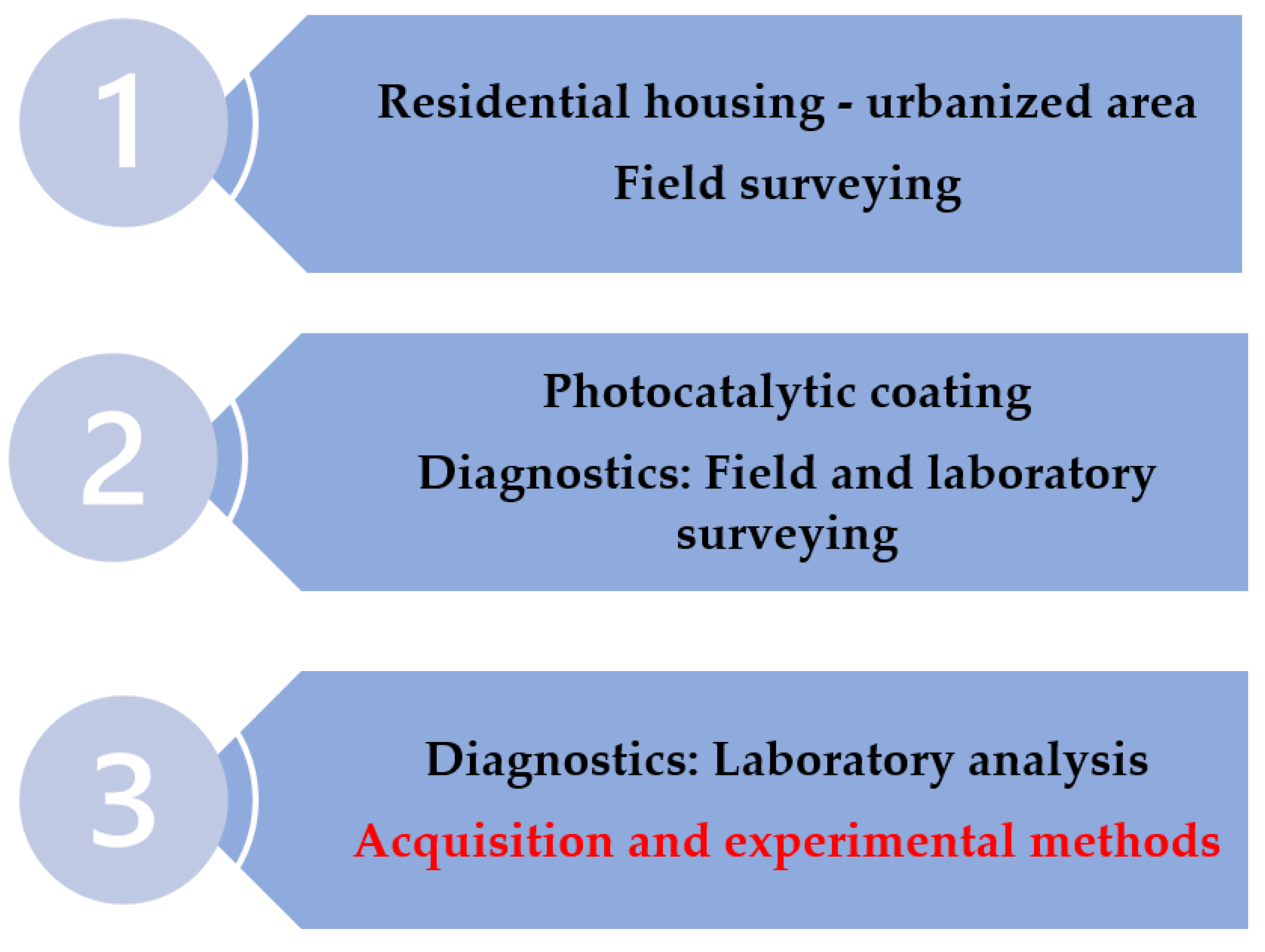
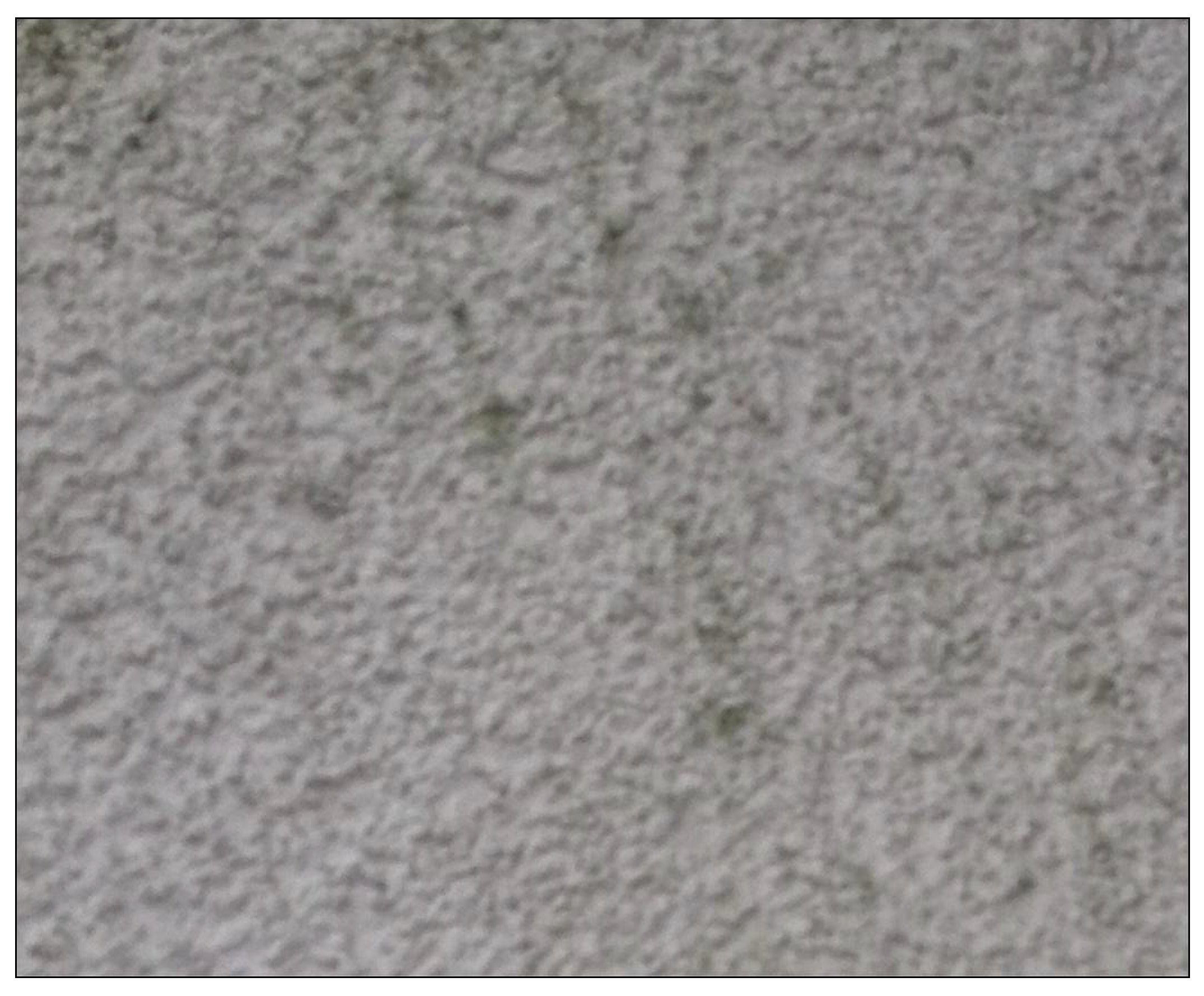
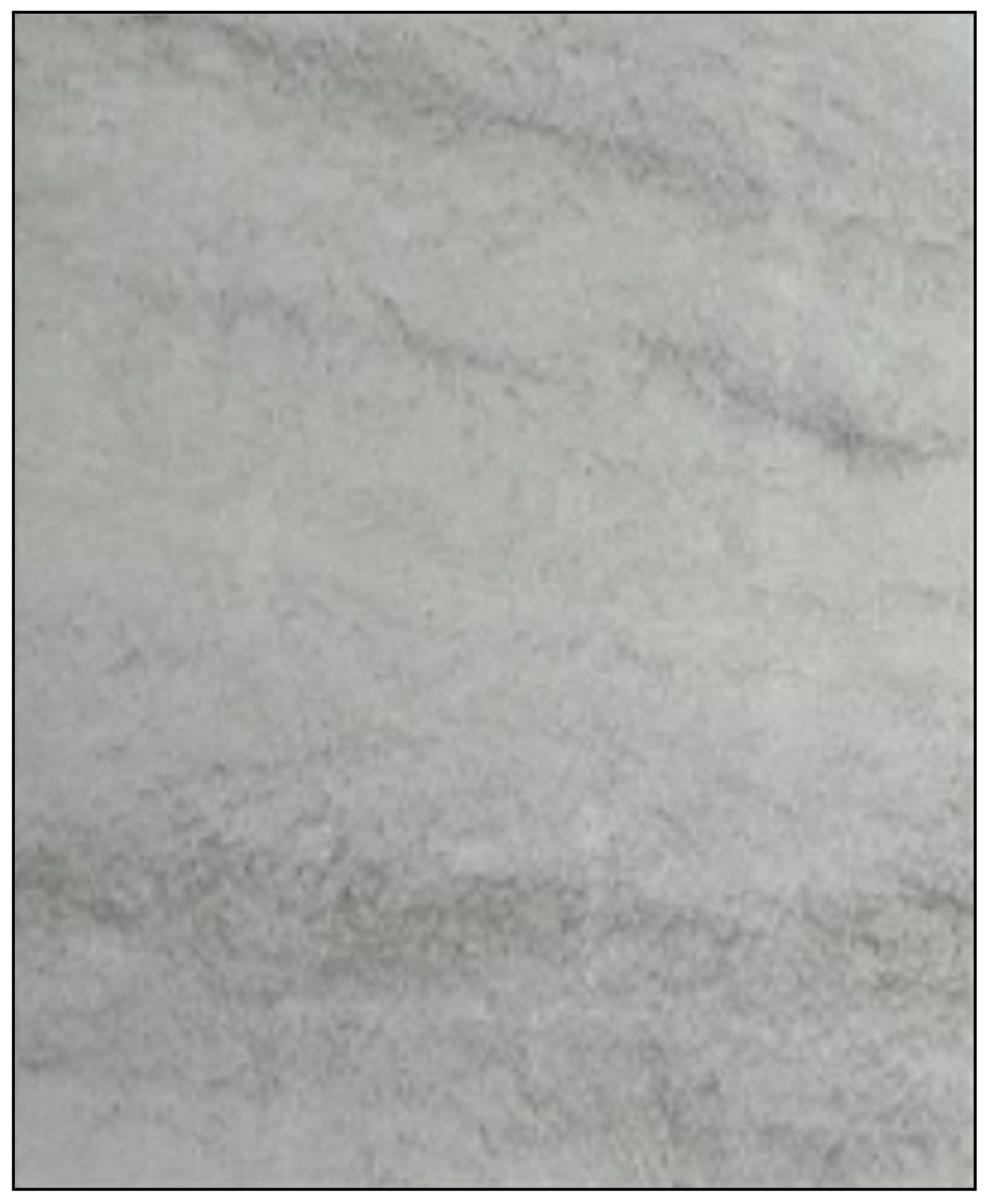
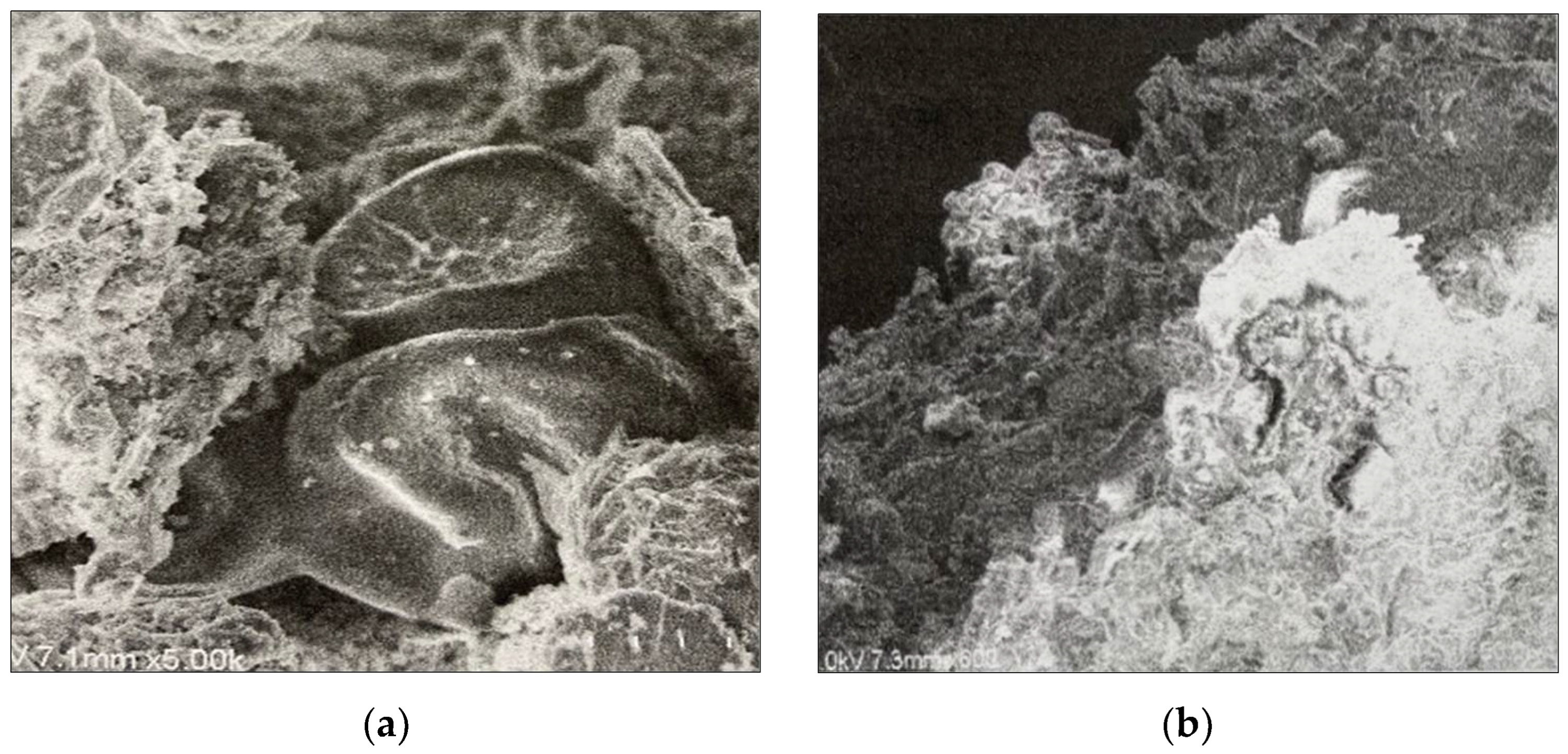
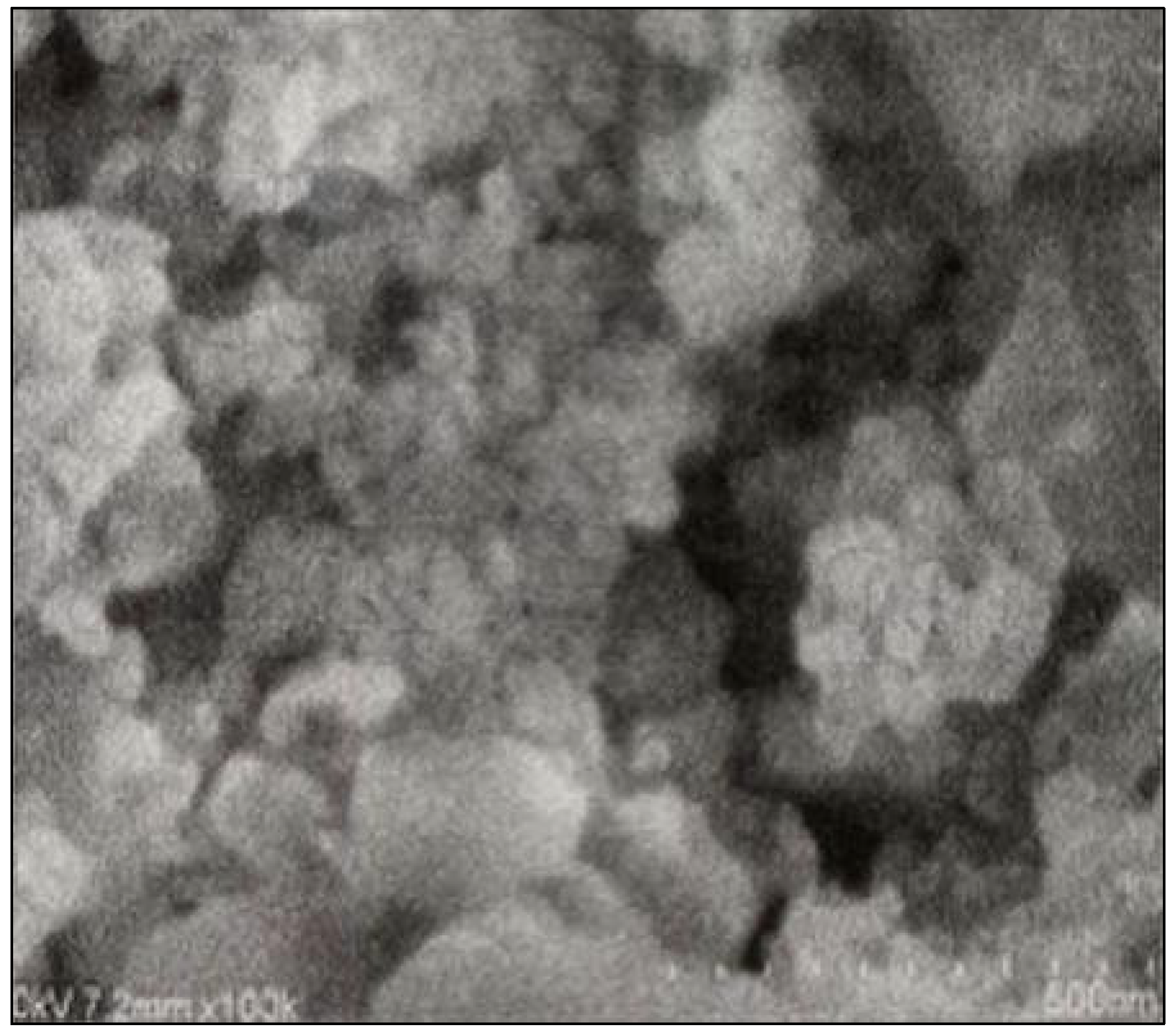
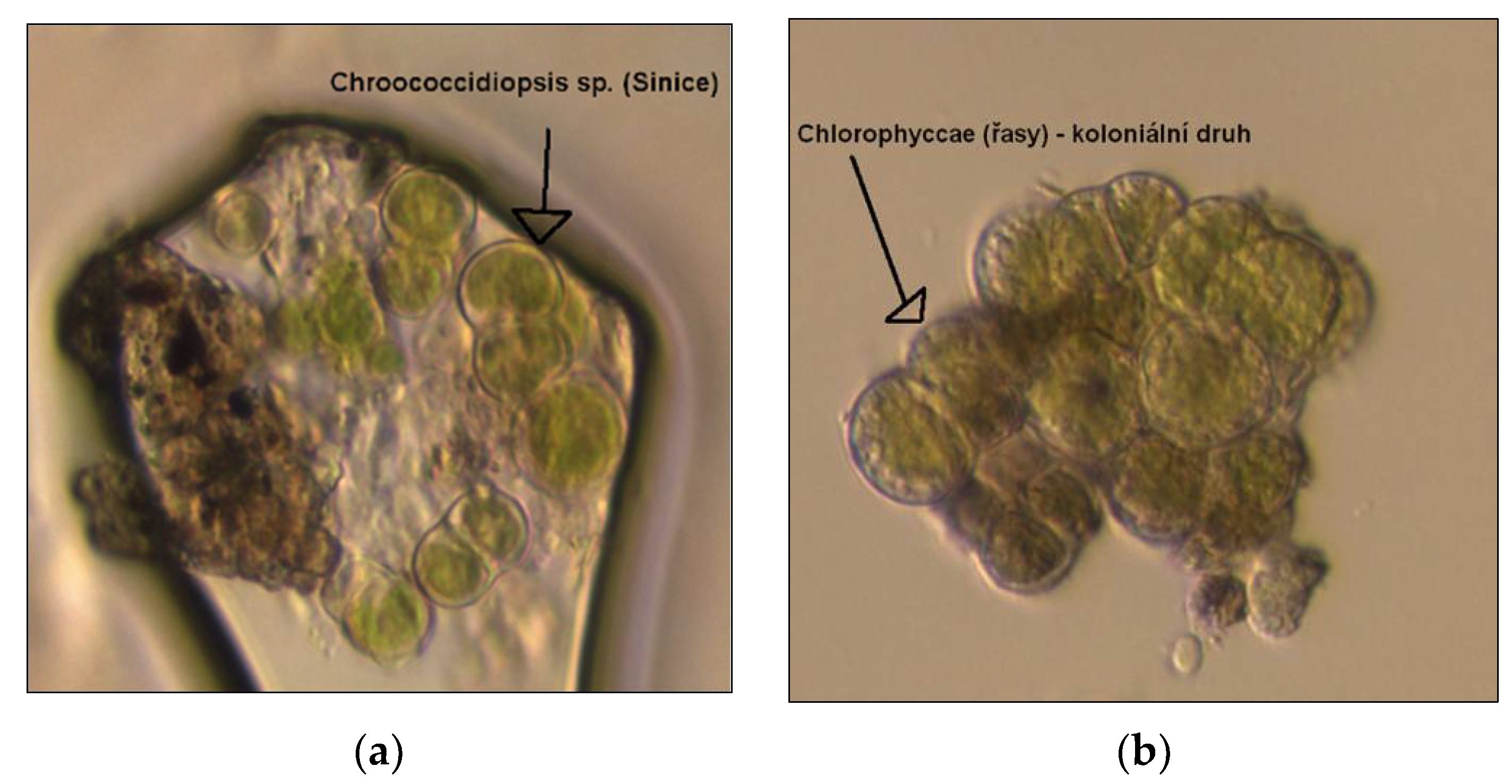

| Number of Houses | Perimeter Cladding | Photocatalytic Coating |
|---|---|---|
| 1 Number of samples: 3 | Facade material solution: Gas silicate block panel th. 300 mm + 150 mm ETICS | Yes |
| 2 Number of samples: 3 | Facade material solution: Reinforced concrete panel th. 300 mm + 150 mm ETICS | No |
| Locality | Number of Buildings (Total) | Number of Buildings with Photocatalytic Coating | Number of Samples from 1 Buildings | Ingrowth of ETICS Microorganisms | Number of Positive Samples: Microorganism | Genus |
|---|---|---|---|---|---|---|
| Ostrava | 9 | 1 | 3 | Yes | 3 | Chlorophycae Alternaria Aspergillus Cladodosporium spores |
| Havířov * Ostrava | 33 9 | 0 0 | 0 3 | Yes Yes | 3 | Chlorophycae Alternaria Aspergillus |
Publisher’s Note: MDPI stays neutral with regard to jurisdictional claims in published maps and institutional affiliations. |
© 2022 by the author. Licensee MDPI, Basel, Switzerland. This article is an open access article distributed under the terms and conditions of the Creative Commons Attribution (CC BY) license (https://creativecommons.org/licenses/by/4.0/).
Share and Cite
Kubečková, D. The Quality of ETICS in the Context of Energy and Social Changes (Case Study). Sustainability 2022, 14, 3135. https://doi.org/10.3390/su14063135
Kubečková D. The Quality of ETICS in the Context of Energy and Social Changes (Case Study). Sustainability. 2022; 14(6):3135. https://doi.org/10.3390/su14063135
Chicago/Turabian StyleKubečková, Darja. 2022. "The Quality of ETICS in the Context of Energy and Social Changes (Case Study)" Sustainability 14, no. 6: 3135. https://doi.org/10.3390/su14063135
APA StyleKubečková, D. (2022). The Quality of ETICS in the Context of Energy and Social Changes (Case Study). Sustainability, 14(6), 3135. https://doi.org/10.3390/su14063135






